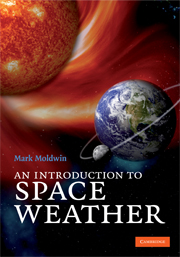Book contents
- Frontmatter
- Contents
- Preface
- Acknowledgments
- 1 What is space weather?
- 2 The variable Sun
- 3 The heliosphere
- 4 Earth's space environment
- 5 Earth's upper atmosphere
- 6 The technological impacts of space storms
- 7 The perils of living in space
- 8 Other space weather phenomena
- Appendix A Web resources
- Appendix B SI units
- Appendix C SI prefixes
- References
- Historical bibliography
- Index
- Plate section
3 - The heliosphere
Published online by Cambridge University Press: 05 June 2012
- Frontmatter
- Contents
- Preface
- Acknowledgments
- 1 What is space weather?
- 2 The variable Sun
- 3 The heliosphere
- 4 Earth's space environment
- 5 Earth's upper atmosphere
- 6 The technological impacts of space storms
- 7 The perils of living in space
- 8 Other space weather phenomena
- Appendix A Web resources
- Appendix B SI units
- Appendix C SI prefixes
- References
- Historical bibliography
- Index
- Plate section
Summary
The heliosphere is defined as the region of interplanetary space where the solar wind is flowing supersonically.
Dessler, A.J. Reviews of Geophysics, 5, 33, 1967. The first use of the term heliosphere in the scientific literature.Key concepts
plasma
solar wind
heliosphere
interplanetary magnetic field
coronal mass ejection
cosmic rays
Introduction
Sunlight, which bathes Earth with heat and light, is only part of the energy that flows constantly from the Sun. Ionized gas (plasma) and magnetic field are continuously expelled as solar wind, as well. Solar wind was discovered in the 1950s when it was noticed that the plasma tail of a comet always points away from the Sun, even when the comet is moving back towards deep space. Figure 3.1 shows a schematic of a typical comet and its tail at different points in its orbit around the Sun. A comet tail is made up of cometary material that has been heated by sunlight as it gets close to the Sun and has escaped from the nucleus. The glowing cloud of neutral and ionized gas and dust around the nucleus is called the coma. The material in the coma is then “blown” back away from the Sun. Creation of a comet tail requires not only sunlight, but also the energy and momentum of a gas flowing supersonically away from the Sun, the solar wind.
- Type
- Chapter
- Information
- An Introduction to Space Weather , pp. 37 - 49Publisher: Cambridge University PressPrint publication year: 2008

